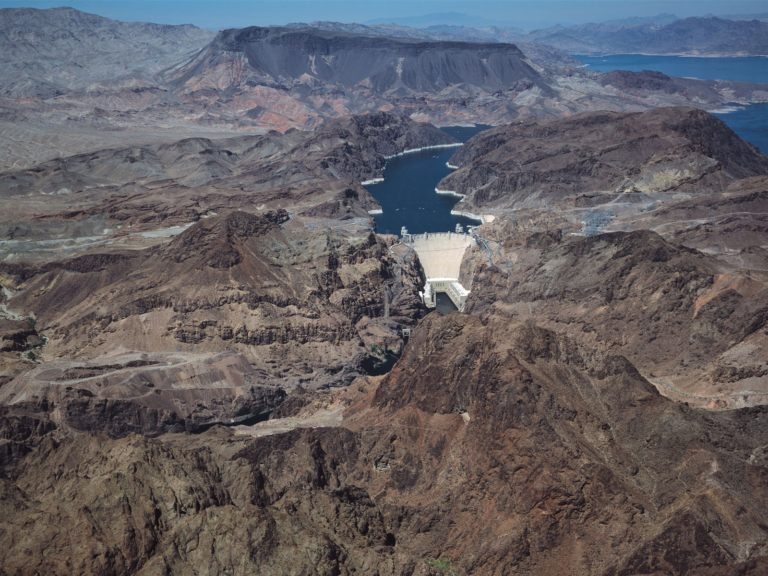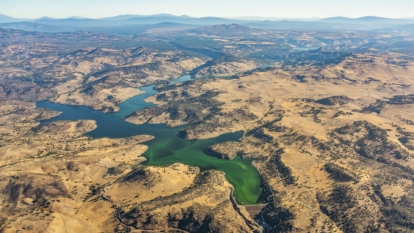What Is the Future of Dams in a Hot, Chaotic World?
An excerpt from Steven Hawley’s book about dirty dams—and their methane problem.
Listen to the story
Dams everywhere have a problem. It turns out they’re all significant emitters of a greenhouse gas that, in the short term, is much more potent than carbon dioxide. Methane made headlines in late 2021 at COP26, the United Nations gathering of world powers held in Glasgow, Scotland, to discuss climate change. Methane is a colorless, odorless gas that’s produced both in natural processes (cow flatulence and underwater plant decomposition) and in industrial activity. Fossil fuel production and consumption produces a lot of methane. Unlike carbon dioxide, which will persist in the atmosphere for centuries, methane dissipates relatively quickly but does a lot more damage while it’s there. According to the EPA, over a century’s time methane is 25 times more effective at trapping atmospheric heat than carbon dioxide. Over a 20-year period, methane is 80 times more effective at heat retention than carbon dioxide. Commitments to cutting methane emissions worldwide became one of the most heralded accomplishments of COP26. Sticking to these commitments will require some fresh scrutiny over existing and planned dams, and at least a passing familiarity with a rapidly growing branch of limnology, the study of biological, chemical, and physical properties of water.
In the early 1990s, a small team of scientists in Brazil started measuring greenhouse gas emissions produced at dams and reservoirs. Led by Philip Fearnside, these scientists found surprising results, indicating that large hydropower projects in tropical countries emit high levels of greenhouse gases, especially methane.
In 2000, Vincent St. Louis, Carol Kelly, Éric Duchemin, John W. M. Rudd, and David M. Rosenberg published a paper in the journal BioScience that described how reservoirs contribute to greenhouse gases. The five scientists furnished data from reservoirs in Brazil, Canada, Finland, Panama, French Guyana, and the northern United States, and called for reservoir emissions to be included in inventories of anthropogenic greenhouse gases.
In 2008, Fearnside published an article in an academic journal, Oecologia Australis, titled, “Hydroelectric Dams as ‘Methane Factories’: The Role of Reservoirs in Tropical Forest Areas as Sources of Greenhouse Gases.” In the article, Fearnside put forth credible evidence that some large hydroelectric projects in tropical locations spew greenhouse gas emissions equivalent to that of large, coal-fired power plants. Around the same time, other scientists around the world launched new studies that supported the conclusions of Fearnside and his colleagues.
Over the past 20 years, international studies of dams and their reservoirs confirmed in dozens of peer-reviewed research papers that dams and reservoirs are net contributors to climate change.

Built during the Depression at fire-sale prices, the construction of Hoover Dam launched what would become the largest construction firms in the United States. Southern Paiute ancestral lands, Nevada. Photo: Carol M. Highsmith
In 2016, the climate cost of large dams was further affirmed when an international team of scientists synthesized dozens of studies from around the planet indicating that methane emissions from dams and reservoirs have been widely ignored and dramatically underestimated. Published in BioScience, the article, titled, “Greenhouse Gas Emissions from Reservoir Water Surfaces: A New Global Synthesis,” was funded by the US Army Corps of Engineers, the Environmental Protection Agency, and the National Science Foundation. The study made international news and recommended that the United Nation’s Intergovernmental Panel on Climate Change (IPCC) revise its calculations and include dams and reservoirs’ significant emissions in climate change scenarios.
Part of the “global synthesis” service, this seminal paper provides an inventory of almost 270 dams worldwide and their estimated methane emissions. Included were Glen Canyon Dam and Reservoir Powell, and Hoover Dam and Reservoir Mead. Per megawatt hour of electricity produced, Powell emits an estimated 228.8 kilograms of carbon dioxide equivalent. Mead spews 1,079 kilograms per megawatt hour. For comparison’s sake, per megawatt hour, an average-sized, gas-fired electricity generating plant emits 407 kilograms of greenhouse gases. According to a report commissioned by the Glen Canyon Institute, from 2010 to 2014, Glen Canyon Dam averaged 4.08 million megawatt hours of power production annually. Do the math: multiplied by the estimate of emissions of methane in the Global Synthesis study, the clean, green hydropower coming out of Reservoir Powell produces 933 million kilograms of carbon dioxide equivalent greenhouse gas in the form of methane each year, equal to the climate cost of 205,000 cars on the road over the same time span.
Tell the EPA to Add Dams and Reservoirs as a Source Category under the Greenhouse Gas Reporting Program
Led by Patagonia, Earthjustice and Save the Colorado River, a diverse coalition of 136 groups has petitioned the U.S. Environmental Protection Agency (EPA) to add America’s dams and reservoirs as a source category under the Greenhouse Gas (GHG) Reporting Program. Currently, over 8,000 facilities—including other energy facilities, fuel and gas suppliers—are required to report their emissions annually, but hydropower is not included. Dams and reservoirs that emit climate-destroying methane, carbon dioxide and nitrous oxide have been shielded from disclosure.
Adding dams and reservoirs to the EPA’s Greenhouse Gas Reporting Program is a critical step to addressing the climate emergency and fulfilling the Biden administration’s focus on methane emissions.
Read the full petition and join the movement.

